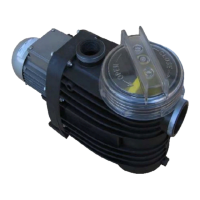9
5 TROUBLE SHOOTING
Please read this section before calling for help.
If you call for help, please refer to the model and serial
numbers. (See SYSTEM REPORT, page 3.)
If The Pump Does Not Run
Most problems are caused by wrong connections (in a
new installation) or failed connections, especially
where a wire is not secure and falls out of a terminal.
The System ON light will indicate that system is
switched on and connected to the controller. It
indicates that VOLTAGE is present but (in a solar-
direct system) there may not be sufficient power to
start the pump. It should attempt to start at intervals of
120 seconds.
Pump attempts to start every 120 seconds but
doesn’t run
The controller makes a slight noise as it tries to start
the pump. The pump will start to turn or just vibrate a
little.
1. There may be insufficient power reaching the
controller. A solar-direct (non-battery) system
should start if there is enough sun to cast a slight
shadow. A battery system should start if the supply
voltage is greater than 44V.
2. If the pump was recently connected (or recon-
nected) to the controller, it may be running in
reverse direction due to wiring error.
3. If the motor shaft only vibrates and will not turn, it
may be getting power on only two of the three
motor wires. This will happen if there is a broken
connection or if you accidentally exchanged one of
the power wires with the ground wire.
4. The pump or pipe may be packed with mud, clay,
sand or debris.
PUMP OVERLOAD (PUMP ON light shows red
instead of green) The system has shut off due to an
overload. This can happen if the motor or pump is
blocked or very difficult to turn and is drawing exces-
sive current (hard to turn). Overload detection requires
at least 250 Watt output of the solar array. This can be
caused by a high concentration of solids in the
pump.The controller will make 3 start attempts before
shutting down the system. The System ON LED will be
OFF and the red OVERLOAD LED ON. The system
will not reset until the ON / OFF switch is turned OFF
and ON again. See Troubleshooting, Section 9.3
“HIGHER CURRENT”.
Inspect the solar array
1. Is it facing the sun?
2. Is there a partial shadow on the array? If only 10%
of the array is shadowed, it can stop the pump!
Inspect all wires and connections
1. Look carefully for improper wiring (especially in a new
installation).
2. Make a visual inspection of the condition of the wires and
connections. Wires are often chewed by animals if they are
not enclosed in conduit (pipe).
3. Pull wires with your hands to check for failed connections.
Inspect the controller
1. Remove the screws from the bottom plate of the controller.
Move the plate downward (or the controller upward) to reveal
the terminal block where the wires connect.
2. First, check for a burnt smell. This will indicate a failure of the
electronics. Look for burnt wires, bits of black debris, and any
other signs of lightning damage.
3. Inspect the grounding wires and connections! Most controller
failures are caused by an induced surge from nearby lightning
where the system is NOT effectively grounded. Ground
connections must be properly made and free of corrosion.
Check the low-water probe system
If the controller indicates “SOURCE LOW” when the pump is in
the water, inspect the low-water probe system. The probe is
mounted on, or near the pump. If inspection is not feasible, you
can bypass the probe or test it electrically.
Check the full-tank float switch
If the controller indicates “TANK FULL” when the storage tank is
not full, inspect the float switch system. If your system has a float
switch, it will be mounted in the tank. If inspection is not feasible,
you can bypass the switch or test it electrically.
Force a quick start
If you restore a connection or bypass the probe or float switch,
there is no need to wait for the normal time delay. Switch the on/
off switch (or the power source) off then on again. The pump
should start immediately if sufficient power is present.
If the pump responds to the bypass tests above but not to the
float switch, the wires may be shorted (touching each other) or
open (broken), or the switch may be stuck with debris, or out of its
correct position.
1. Is the solar array receiving shadow-free light? (It only takes a
small shadow to stop it.) Is it oriented properly toward the
south, and tilted at the proper angle?
2. Be sure you have the right pump for the total lift that is
required.
3. Be sure all wire and pipe runs are sized adequately for the
distance. Refer to wire sizing in the pump sizing table.
4. Inspect and test the solar array circuit and the controller
output, as above. Write down your measurements.
5. There may be a leak in the pipe from the pump.
6. There is a “max. RPM” adjustment in the controller. It may
have been set to reduce the flow as low as 30%.
Manual PS600 BADU Top 12

